Neil Greenberg premieres This at New York Live Arts.
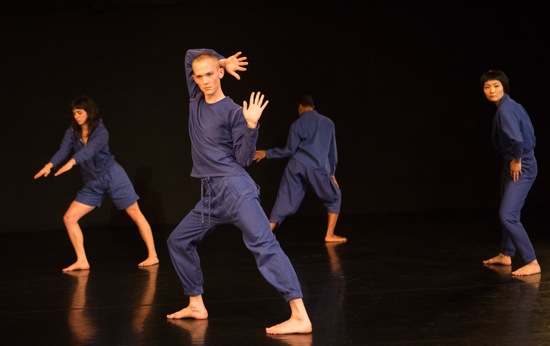
Neil Greenberg’s This. (L to R): Molly Lieber, Connor Voss, Omagbitse Omagbemi. and Mina Nishimura. Photo: Yi-Chun Wu
Choreographer Neil Greenberg doesn’t like the word “about,” as in, “What is this dance about?” Having been a member of Merce Cunningham’s company between 1979 and 1986 and having read Susan Sontag’s influential 1966 Against Interpretation, he would prefer we not scramble to uncover “meaning” while watching what he puts onstage. The title of his new work, This, doesn’t attempt to mystify us; it’s a warning. “This” means that Molly Lieber, Mina Nishimura, Omagbitse Omagbemi, and Connor Voss will perform, alone or together, for a little under an hour in New York Live Arts’ black-box theater, while gusts of recorded music by Steve Roden pass through, and the lighting, devised by Joe Levasseur, intermittently changes the look of the environment. And while we are watching what evolves, we will do our best not to imagine hidden stories or messages or fraught relationships.
Knowing how hard this will be for some people, Greenberg has devised a strategy to keep our narrative urges at bay. During the rehearsal process, he asked his intrepid colleagues to improvise in relation to various ideas or rules. He taped the sessions and made choices; the dancers studied the videos in order to reproduce exactly what they had spontaneously invented. That procedure, plus Greenberg’s weaving, repeating, and overlapping the bits of the learned material, distances the resulting work from whatever generated the movements.
Of course, we don’t see the creative process, we only read about it in his program essay. But that process has clung to the atmosphere of the dance. This is “about” four dancers dancing in a situation designed to frame them. They approach what they do as tasks to be focused on and fulfilled. Having completed one segment, they may leave NYLA’s performing space for a few minutes, and re-enter when the time comes. Sometimes one of them initiates a passage of movement that others join and, maybe, detach themselves from. They watch one another for cues. At one moment, Omagbemi is turning and turning on one spot; others have been doing this too, and now they wait, standing where they’ve been told to stand, until their colleague has finished and is ready to embark on the next sequence with them.
Does this sound dry? Boring? It’s not. I watched This enthralled. The movements are fascinating, as is the expertise with which Greenberg has ordered them and the skill and fullness that the dancers bring to them. Since they are human beings, we can’t completely refrain from attributing moods or relationships to them, but Greenberg has tamped down interpretation by collaging his elements and avoiding images of cause and effect on a narrative level. One of these elements, for instance, has performers teetering around, reeling a little, their focus wandering. Does “dizzy” cross your mind? Or “drunk?” Of course it does. But you let these images go, because the act has no repercussions and bears little resemblance to what precedes or—quite smoothly—follows it.
Levasseur’s inventive lighting suggests that he too has consolidated possibilities that could intimate drama (at one point, incurable, I wrote “sepulchral’ in my notes) and then treated them as if they don’t. Most of the lights are on two “trees,” one situated in the performing area a little to one side of center, the other in an upstage corner. By my count, there could be as many as two dozen naked lamps on the one nearest the audience. The look of the stage changes subtly for the most part, but a blaze of white light may startle you, or a burst of red that disappears almost instantly. Near the end of This, Levasseur creates a wild display of changes that could be reprising effects that occurred over the course of the work.
Roden’s score can also be considered atmospheric, but it’s not insistent. For one thing, segments of it are interrupted by long silences. Distant resonant sounds sneak in a few minutes after the dance begins and, after a while, fade away. The music may return as a high ringing with what sound like faraway voices embedded in it. Later, a rising wail, somewhat like that of a siren, surfaces over and over.
The costumes by Jerome Kidd Studio hint at changes of atmosphere too. The dancers start out wearing various rough-and-ready clothes in the blue-gray range, then change to outfits that are cut in more or less the same way, but are made of a light, shiny blue-green material. Their final attire is bulkier, made of beige fabric that looks knitted.
There are many duets in This, but very little physical contact. And, often, for long stretches of time, the two onstage seem to be engaged in individual pursuits (they slip into unison—if they do—as if by magic). For instance, Omagbemi the first to appear onstage, is moving slowly when Lieber runs in, dives, and slides on her belly; while she is repeating the sequence that this act begins, Omagbemi is training a speculative gaze on the audience, as if we were her mirror. She, too, repeats her own calm moves and gestures. When Voss and Nishimura join these too, they come bearing their own preoccupations—with Voss introducing that wandering gaze.
One of the pleasures of watching Greenberg’s elegant composition is revisiting, via repetition and recurrence, steps that you like becoming friends with. It’s somewhat like the sensation you have when you encounter on the street or at a performance someone you just met last week—same face and smile, different clothes, different circumstances.
You find yourself identifying newcomer-moves, like a balance with one leg lifted behind in something like a ballet attitude; a big jump with both legs squeezed together in the air; a loose gallop; a wiggle of the hips; a clunky, stamping, spraddle-legged walk; a tiptoe progress with flapping hands—even as you welcome the old acquaintances back. When, late in the game, Omagbemi starts playing a new game, wrapping one leg around the other as she dances on, you want to yell out, “hello there, stranger!”
It becomes intriguing to discover differences among the marvelous performers. Voss and Omagbemi attack a particular recurring solo. The task is to enter alone, hold up a piece of fabric (a part of their costume) that they’ve stuck in their waistbands and run swiftly with it (the Olympic flag-bearer image is a strong one). Then they stop and use it to whip the floor. Then they lash it in circles with one powerful arm. In their separate appearances, the two accurately reproduce the same actions, down to the manner of entering and exiting, but you still see subtle distinctions, and images flash willy-nilly into your brain.
This is strenuous. Leaps and turns enter the arena, so does a big, bustling stride that resonates with (but does not mimic) a race walk. But Greenberg is not a one-note choreographer. He delves into the explosive versus the melting, the powerful versus the uncertain, the expansive versus the intimate, angles versus curves, stillness versus motion. And more.
All right, Greenberg’s piece is about itself, although a lot depends on how you define “about” and what “itself” covers. I’ll put aside such tempting speculation in favor of cloaking what Sontag termed “the sensuous surface” of an art work with words like “alluring” and “fascinating.” I’d gladly sit down and take in this busy, lucid little world (oops, sorry, dance) all over again.

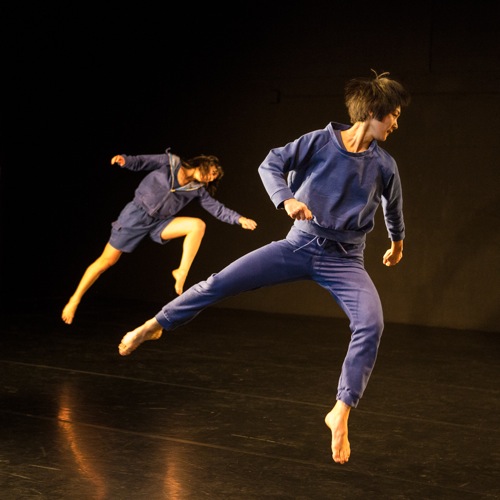
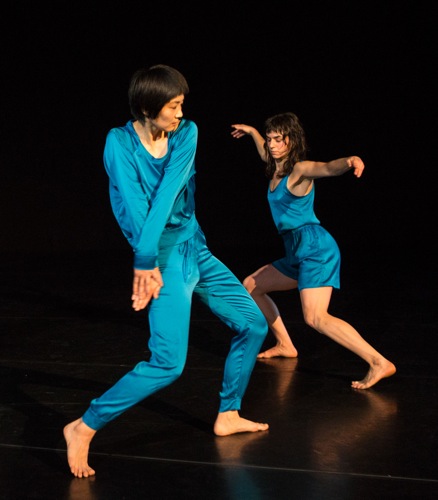
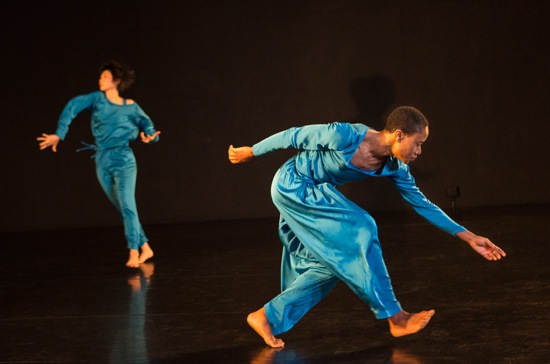
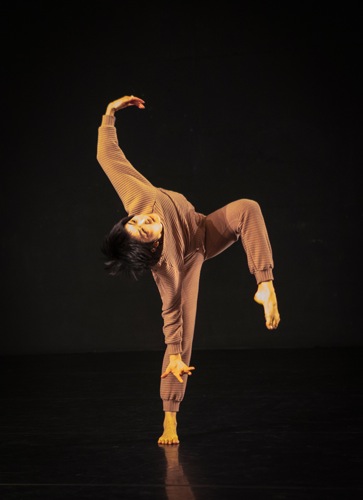
I always liked this Balanchine quote: “We dare to go into the world where there are no names for anything…we get our hands into that just a little bit.”
Thank you for adding this. I like these words of Balanchine’s too. And Jerome Robbins, who was the colleague referred to in that “we,” was thrilled to be allied with the choreographer he most admired.